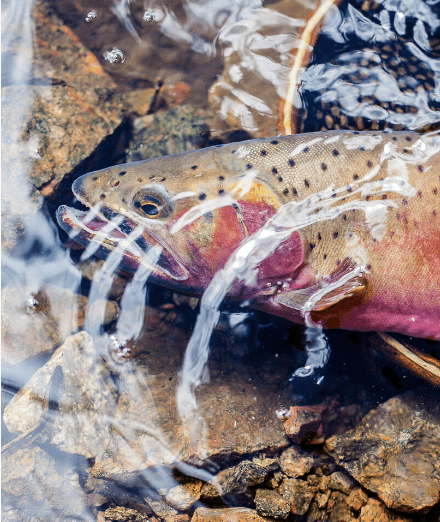Rio Grande Cutthroat Trout Information
Rio Grande Cutthroat Trout Information
Native to Southern Colorado and Northern New Mexico, the Rio Grande Cutthroat is the southernmost-dwelling of the fourteen recognized strains of cutthroat trout native to the American West. Likely the first strain of cutthroat seen by European settlers in North America, Rio Grande cutties commonly exhibit a uniquely dark hue along the tops of their bodies and the tips of their jaws. Like most cutthroat strains, they also boast a vibrant red and purple dash across the bottom of their jaw and their underbelly. Rio’s usually feature a spot pattern that is lightly dispersed across the sides of their bodies and congested on their tail. Like most cutthroat species, the Rio Grande was once listed as endangered, and currently inhabits only 12% of its historical range according to Colorado Parks and Wildlife. Even so, anglers are allowed to fish for Rio Grandes, and catching one is truly the experience of a lifetime; that being said, an eye towards the conservation of this fascinating and elusive species is important.

Size and Habitat
Like most of the cutthroat species native to Colorado, Rio Grandes are often found in the 6 to 12 inch range. A fish of this species over 14 inches is exceedingly rare, and would certainly be considered the catch of a lifetime; they’re out there though! The fact that most adult Rio Grandes do not grow larger than a ruler is due to the size of the bodies of water they inhabit. Rio’s are often found in small, cold, high alpine streams, and currently live in only 800 total miles of river between southern Colorado and northern New Mexico. These fish can also be found in high alpine lakes, many even above treeline, that are frozen for around three quarters of the year. Most of these lakes are very remote, meaning that there is little to no fishing pressure on them. So, if you can find one of these lakes and are willing to put in a long hike, you will likely be met by trout very willing to eat whatever fly you throw at them. Just remember to practice safe fish-handling techniques like wetting your hands before touching the trout, keeping the trout in the water, and avoiding touching the gills or mouth of your catch.
When They Spawn and How to Target Them
All cutthroat and rainbow trout spawn in the spring, the exact timing depending on the temperature of the water they inhabit. Because Rio Grande Cutthroat tend to live in cold and elevated waterways, their spawning period can be as late as June or even into July. Rio Grande trout spawn like other trout do, with the females beating their tails into the ground in a shallow, well-oxygenated section of a stream to create a spawning bed that is known as a redd. This is where she will lay her eggs, and once a male fertilizes them, a small percentage will hatch into Rio Grande Cutthroat fry. Because the native stock of these fish is so low, it is very important to avoid disrupting the spawning process. If you encounter an off-colored bed of rocks in a shallow, fast-moving part of a stream during the spring, make sure to avoid wading or fishing in that section. In the summer, Rio Grande Cutthroat are quite opportunistic in feeding because their window to eat large hatches is whenever there is no winter weather, which in the high country is usually just the months of June to early October. Thus, Rio Grande Cutthroat are not usually very picky about your choice of flies. They do, however, live in very clear and small streams, so a stealthy approach when fishing for them is important. Good luck!
